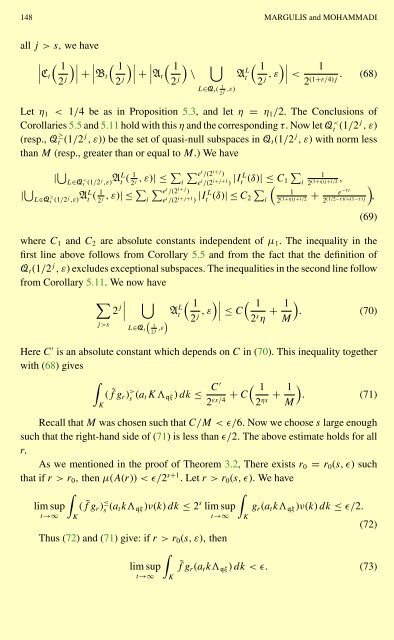NEAR OPTIMAL BOUNDS IN FREIMAN'S THEOREM
NEAR OPTIMAL BOUNDS IN FREIMAN'S THEOREM
NEAR OPTIMAL BOUNDS IN FREIMAN'S THEOREM
Create successful ePaper yourself
Turn your PDF publications into a flip-book with our unique Google optimized e-Paper software.
148 MARGULIS and MOHAMMADI<br />
all j>s,we have<br />
<br />
1<br />
Ct<br />
2j <br />
<br />
+<br />
<br />
Bt<br />
<br />
1<br />
2j <br />
<br />
+<br />
<br />
At<br />
1<br />
2 j<br />
<br />
\ <br />
L∈Qt ( 1<br />
2j ,ε)<br />
AL <br />
1<br />
<br />
<br />
t ,ε <<br />
2j 1<br />
. (68)<br />
2 (1+ε/4)j<br />
Let η1 < 1/4 be as in Proposition 5.3, andletη = η1/2. The Conclusions of<br />
Corollaries 5.5 and 5.11 hold with this η and the corresponding τ.Now let Q < t (1/2j ,ε)<br />
(resp., Q ≥ t (1/2 j ,ε)) be the set of quasi-null subspaces in Qt(1/2 j ,ε) with norm less<br />
than M (resp., greater than or equal to M.)Wehave<br />
| <br />
L∈Q < t (1/2j ,ε) AL 1<br />
t (<br />
| <br />
L∈Q ≥ t (1/2 j ,ε) AL t<br />
( 1<br />
2 j ,ε)|≤ <br />
i<br />
t i+j e /(2 )<br />
i et /(2i+j+1 )<br />
t i+j e /(2 )<br />
et /(2i+j+1 )<br />
2 j ,ε)| ≤ <br />
<br />
L |It (δ)| ≤C1 i<br />
L |It (δ)|≤C2<br />
<br />
<br />
i<br />
1<br />
2 (1+η)j+i/2 +<br />
1<br />
2 (1+η)j+i/2 ,<br />
e −τt<br />
2 (1/2−τ)i+(1−τ)j<br />
where C1 and C2 are absolute constants independent of µ1. The inequality in the<br />
first line above follows from Corollary 5.5 and from the fact that the definition of<br />
Qt(1/2 j ,ε) excludes exceptional subspaces. The inequalities in the second line follow<br />
from Corollary 5.11. Wenowhave<br />
<br />
2 j<br />
<br />
<br />
<br />
j>s<br />
L∈Qt<br />
<br />
1<br />
2j ,ε<br />
<br />
,<br />
(69)<br />
AL <br />
1<br />
<br />
1<br />
t ,ε ≤ C<br />
2j 2s 1<br />
<br />
+ . (70)<br />
η M<br />
Here C ′ is an absolute constant which depends on C in (70). This inequality together<br />
with (68) gives<br />
<br />
K<br />
( fgr) ˜ ><br />
s (atKqξ) dk ≤ C′<br />
+ C<br />
2εs/4 <br />
1 1<br />
+<br />
2ηs M<br />
<br />
. (71)<br />
Recall that M was chosen such that C/M < ɛ/6. Now we choose s large enough<br />
such that the right-hand side of (71)islessthanɛ/2. The above estimate holds for all<br />
r.<br />
As we mentioned in the proof of Theorem 3.2, There exists r0 = r0(s, ɛ) such<br />
that if r>r0, then µ(A(r)) r0(s, ɛ). We have<br />
lim sup<br />
t→∞<br />
<br />
K<br />
( fgr) ˜ ≤<br />
s (atkqξ)ν(k) dk ≤ 2 s lim sup<br />
t→∞<br />
<br />
K<br />
gr(atkqξ)ν(k) dk ≤ ɛ/2.<br />
(72)<br />
Thus (72) and(71) give:ifr>r0(s, ε), then<br />
<br />
lim sup<br />
t→∞<br />
fgr(atkqξ) ˜ dk < ɛ. (73)<br />
K

















